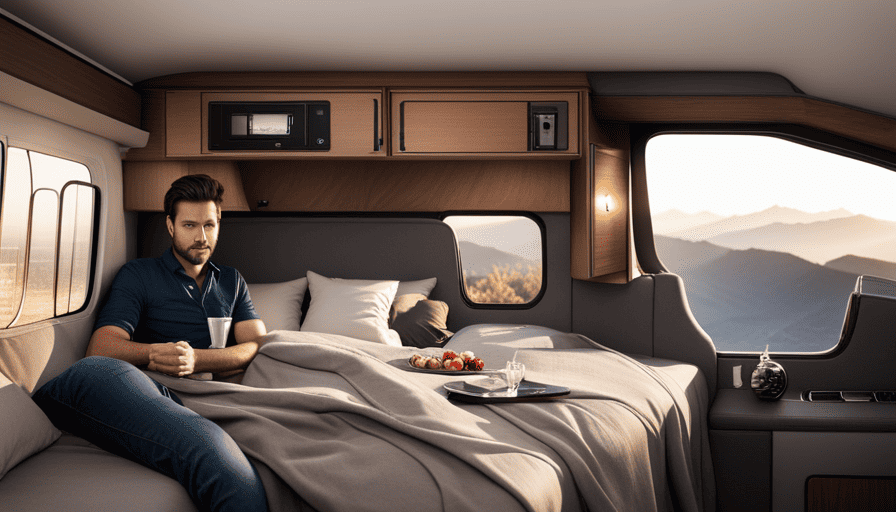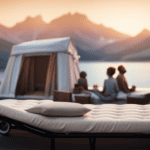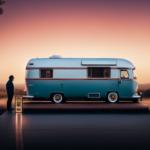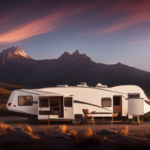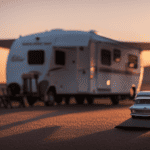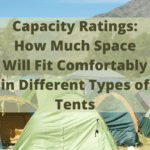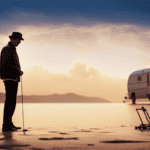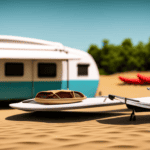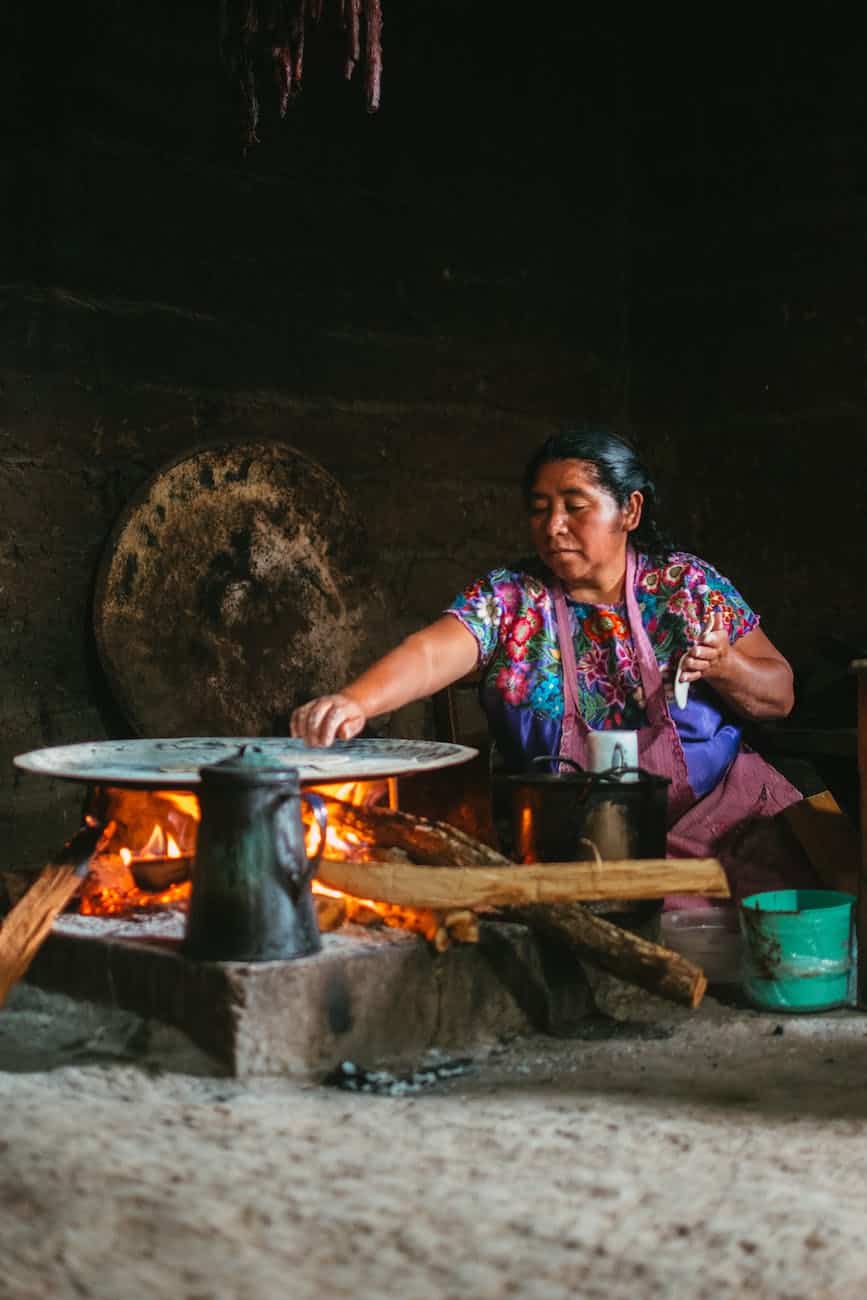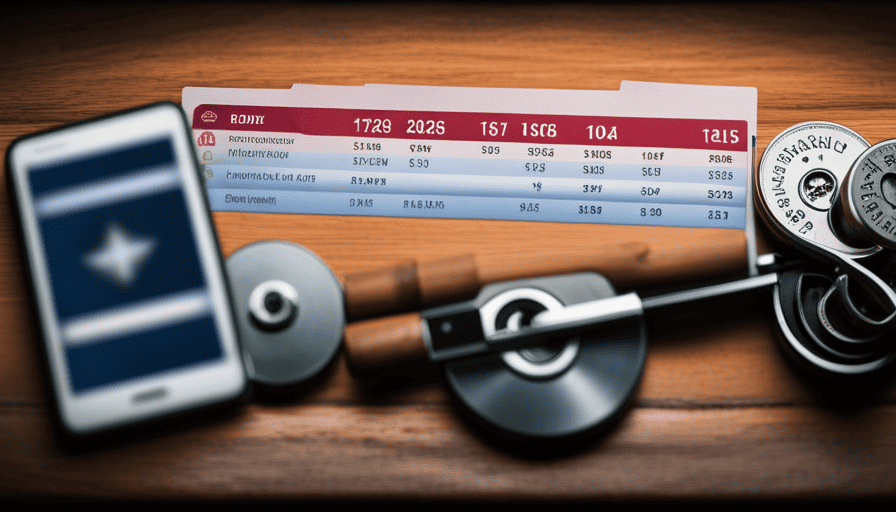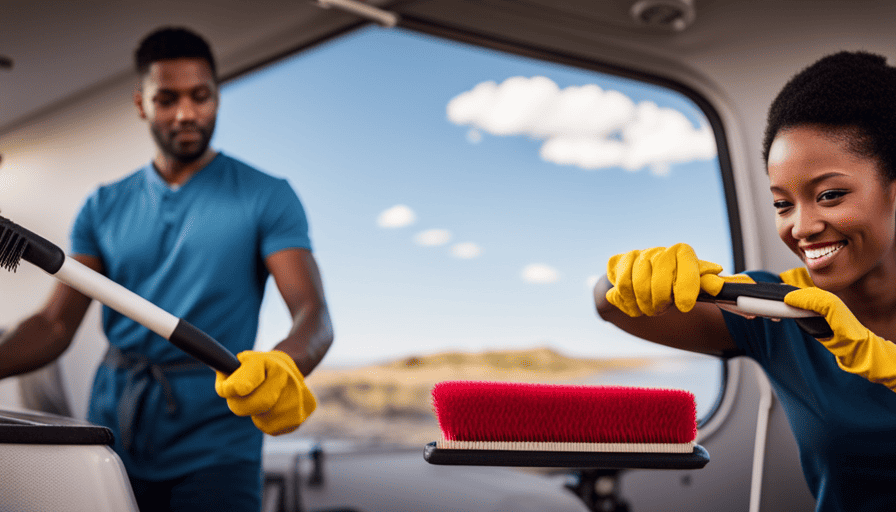Envision the excitement of sleeping under the vast, starlit sky, the soothing crackle of a campfire, and being enveloped by the calmness of the wilderness around you. Now, envisage yourself snugly nestled in a pop-up camper bed, enveloped in a sense of safety and security as you ease into sleep. However, pause for a moment – have you considered the weight capacity of that bed? This is an important question, and it’s one that deserves careful consideration.
As a seasoned camper, I understand the importance of knowing the limits of your equipment, especially when it comes to something as crucial as your sleeping arrangements. In this article, we will explore the weight capacity of pop-up camper beds and provide you with practical guidelines to ensure your safety and comfort. We will discuss the different types of beds, factors that affect weight capacity, and tips for distributing weight properly.
So, let’s dive in and make sure your pop-up camper bed is up to the task of supporting you for a restful night’s sleep.
Key Takeaways
- The weight capacity of pop-up camper beds varies depending on the model and manufacturer.
- Distributing weight evenly and avoiding imbalance is crucial for stability.
- Pop-up camper beds may not be suitable for storing heavy gear, so alternate storage options should be considered.
- Consult with a pop-up camper expert or hire a professional to assess and modify the bed if necessary for safety and longevity.
Types of Pop-up Camper Beds
You’ll be thrilled to discover the various types of pop-up camper beds available! When it comes to pop-up camper beds, there are a few different options to choose from.
The most common types of pop-up camper beds include slide-out beds, bunk beds, and dinette beds. Slide-out beds are a popular choice for pop-up campers because they provide extra sleeping space without taking up too much room when not in use. These beds typically slide out from the side of the camper and can be easily pulled back in when you’re ready to hit the road.
Bunk beds are another option for pop-up campers. These beds are stacked on top of each other, saving space and providing additional sleeping areas. They’re a great choice if you have children or need extra sleeping space for guests.
Dinette beds are a versatile option for pop-up campers. These beds convert from a dining area to a sleeping area by simply folding down the table. They’re a convenient choice if you need a multipurpose space during the day and a comfortable bed at night.
When it comes to pop-up camper bed sizes, they can vary depending on the model and manufacturer. Most pop-up camper beds can comfortably accommodate two adults, but some may have larger sizes available. It’s important to check the specifications of your specific camper to determine the size of the bed.
In terms of mattresses for pop-up campers, there are different options available. Some campers come with foam mattresses, while others may have air mattresses or even memory foam mattresses. It’s important to choose a mattress that provides enough support and comfort for a good night’s sleep.
Now let’s discuss weight capacity guidelines for pop-up camper beds.
Weight Capacity Guidelines
Ensure that you adhere to the weight capacity guidelines when considering the load-bearing capacity of your pop-up camper’s sleeping area. It’s crucial to understand the weight distribution and weight limits to ensure the safety and durability of your camper bed. Ignoring these guidelines can lead to structural damage, discomfort, and even accidents.
To evoke emotion and emphasize the importance of weight capacity, consider the following bullet points:
- Safety First: By adhering to weight limits, you’re prioritizing the safety of yourself, your loved ones, and other campers on the road.
- Peace of Mind: Knowing that you’re within the recommended weight capacity allows you to relax and enjoy your camping experience without worrying about potential damage or accidents.
Now, let’s transition into the subsequent section about factors affecting weight capacity. It’s essential to understand that weight capacity isn’t solely determined by the structure of the camper bed. Factors such as the camper’s overall weight, suspension system, and frame strength also play a significant role. By considering these factors, you can make informed decisions about the weight you load onto your camper bed and ensure a comfortable and secure camping experience.
Factors Affecting Weight Capacity
Unlock the secret to a truly worry-free camping experience by delving into the hidden influences that determine the strength and resilience of your cozy sanctuary on wheels. When it comes to determining the weight capacity of a pop-up camper bed, there are several factors that come into play.
These factors include the materials used in the construction of the bed, the design and support system of the bed, and the overall construction quality of the camper itself.
The materials used in the construction of the bed can greatly impact its weight capacity. Beds made from lightweight materials such as aluminum or composite materials may have lower weight capacities compared to beds made from heavier materials like steel. Additionally, the design and support system of the bed also play a crucial role. Beds with additional support bars or reinforced frames tend to have higher weight capacities compared to beds with simpler designs.
Furthermore, the overall construction quality of the camper itself is an important factor to consider. A well-built camper with sturdy walls and a solid foundation will be able to support more weight on its bed compared to a camper with weaker construction. It’s essential to consider the weight capacity of the bed in relation to the overall weight capacity of the camper to ensure safe and comfortable camping trips.
Transitioning into the subsequent section about distributing weight on the bed, it’s important to understand the impact of weight distribution on the overall stability and performance of the camper.
Distributing Weight on the Bed
Maximize your comfort and stability by strategically placing your belongings on the cozy sanctuary that cradles you. Distributing weight evenly on the pop-up camper bed is crucial for maximizing weight capacity and ensuring a safe and enjoyable camping experience.
When it comes to distributing weight, it’s important to consider the layout of the bed. Start by placing heavier items closer to the center of the bed, where the frame is reinforced. This will help distribute the weight evenly and prevent any strain on the bed’s structure.
Avoid placing all the weight on one side, as this can cause the camper to become unbalanced and potentially tip over.
Additionally, utilize available storage compartments and cabinets to evenly distribute the weight. Spread out heavier items throughout these compartments, rather than stacking them all in one spot. This will help prevent any excessive stress on specific areas of the bed.
By distributing weight evenly and strategically, you can maximize the weight capacity of your pop-up camper bed and ensure a comfortable and stable sleep.
Now, let’s explore some additional considerations for heavy items that you may want to bring along on your camping adventure.
Additional Considerations for Heavy Items
When it comes to heavy items in a pop-up camper, it’s important to understand the limitations of the beds. They aren’t designed to support a lot of weight, so it’s best to avoid placing heavy gear directly on them. Instead, consider alternate storage options like using the floor or cabinets to distribute the weight more evenly and prevent damage to the beds.
Understand the Limitations of Pop-up Camper Beds for Heavy Items
Discover the hidden strength of your pop-up camper bed and see just how much weight it can handle for those heavy items. You might be surprised at how much weight these beds can hold when properly secured.
Here are a few types of heavy items that you can safely store on your pop-up camper bed:
-
Camping gear: Whether it’s a cooler full of food or a bulky tent, your pop-up camper bed can handle the weight of your camping essentials.
-
Sports equipment: From bikes to kayaks, your pop-up camper bed can securely hold your favorite sports gear.
-
Tools and equipment: Need to transport heavy tools for your outdoor projects? Your pop-up camper bed can handle the weight.
-
Extra supplies: Whether it’s firewood or extra water jugs, your pop-up camper bed can handle the load.
When securing heavy items on your pop-up camper bed, make sure to distribute the weight evenly and use straps or bungee cords to keep everything in place. However, if you find that your pop-up camper bed isn’t suitable for storing heavy gear, consider alternate storage options.
Consider Alternate Storage Options for Heavy Gear
To find suitable storage options for heavy gear, you may want to consider alternate storage solutions that can effectively accommodate the weight and size of your items.
Pop-up camper beds have limitations when it comes to holding heavy items, so it’s important to explore other options. One alternative is to use weight distribution techniques, such as placing heavier items closer to the center of the camper or distributing the weight evenly across the bed.
Additionally, you can consider utilizing storage compartments or bins outside the camper to free up space in the bed for lighter items. By thinking creatively and utilizing alternate storage methods, you can ensure that your heavy gear is safely stored without putting excessive strain on the camper bed.
Assessing the condition of the bed is the next step in ensuring a safe and secure storage solution.
Assessing the Condition of the Bed
The bed of the pop-up camper is capable of supporting a considerable amount of weight, ensuring a restful and secure night’s sleep. However, before loading it up with heavy gear, it’s important to assess the condition of the bed and measure its weight capacity.
Start by inspecting the bed frame for any signs of damage such as cracks or weak spots. Check the hinges and latches to ensure they’re in good working condition. If you notice any issues, it’s essential to address them before adding any weight.
To determine the weight capacity of the bed, refer to the manufacturer’s specifications or consult the owner’s manual. It’ll provide you with the maximum weight limit that the bed can safely support. Keep in mind that this weight limit includes both the weight of the occupants and any additional gear or equipment placed on the bed. Overloading the bed can lead to structural damage and compromise your safety.
Once you’ve assessed the condition and determined the weight capacity of the bed, you can make informed decisions about what gear to bring along. It’s important to prioritize lightweight and compact items to minimize the strain on the bed. Additionally, consider using alternate storage options for heavy gear, such as secure storage compartments or roof racks.
Assessing the condition of the bed and measuring its weight capacity is crucial to ensure a safe and comfortable experience in your pop-up camper. By doing so, you can make informed decisions about what gear to bring and avoid overloading the bed.
Now let’s discuss some safety tips for sleeping in a pop-up camper bed.
Safety Tips for Sleeping in a Pop-up Camper Bed
Now that we’ve assessed the condition and weight capacity of the bed, let’s explore some safety tips for a restful night’s sleep in your pop-up camper. Sleeping in a pop-up camper bed can be cozy and convenient, but it’s important to be aware of the potential dangers. Here are some tips for maximizing comfort and safety:
-
Use a mattress topper: Adding a mattress topper can provide extra cushioning and support, making your bed more comfortable to sleep on. It can also help protect your body from any pressure points or discomfort.
-
Secure loose items: Make sure to secure any loose items around your bed before going to sleep. This includes pillows, blankets, and any other personal belongings. This will prevent them from falling onto you during the night and potentially causing injury.
-
Keep the bed area clear: It’s important to keep the area around your bed clear of any obstacles or tripping hazards. This will help prevent accidents when getting in and out of bed, especially during the night when visibility may be limited.
By following these safety tips, you can have a comfortable and worry-free night’s sleep in your pop-up camper bed. Remember to consult the manufacturer’s guidelines for specific recommendations on weight capacity and any additional safety precautions.
Consult the Manufacturer’s Guidelines
Make sure you check out the manufacturer’s guidelines to ensure you’re following the proper recommendations for your pop-up camper. It’s important to know the weight capacity of your camper bed so that you can sleep comfortably and safely. The weight capacity can vary depending on the type of camper mattress you have and other factors that can affect mattress durability.
To give you an idea of the weight capacity of different types of camper mattresses, take a look at the table below:
| Mattress Type | Weight Capacity |
|---|---|
| Foam Mattress | Up to 250 lbs |
| Innerspring Mattress | Up to 500 lbs |
| Air Mattress | Up to 600 lbs |
It’s worth noting that these weight capacities are just general guidelines and may vary depending on the specific manufacturer and model of your camper. Always consult the manufacturer’s guidelines for the most accurate information.
Factors that can affect mattress durability include the quality of materials used, construction techniques, and overall design. It’s important to consider these factors when choosing a camper mattress to ensure that it can withstand the weight of the sleepers.
Now that you know about the weight capacity of different types of camper mattresses and the factors that can affect mattress durability, let’s move on to the next step: testing the bed’s stability.
Test the Bed’s Stability
Ensure the bed is as solid as a rock before you lay down to sleep in your cozy pop-up oasis. To test the bed’s stability, there are a few methods you can try.
Start by carefully sitting on different areas of the bed and shifting your weight around. Pay attention to any creaking or wobbling that may indicate structural weaknesses.
Next, try gently bouncing on the bed to simulate the movements you might make while sleeping. If the bed feels sturdy and doesn’t make any unusual noises, it’s a good sign that it can handle your weight.
Another test method is to place some weights on the bed and gradually increase the load. Use a bathroom scale to measure the weight you’re adding. Analyze the results to ensure that the bed can support your weight comfortably.
If you notice any signs of instability or if the bed fails to meet your weight requirements, it’s important to seek professional advice. They can assess the situation and provide guidance on how to strengthen the bed or recommend alternative options.
Seek Professional Advice if Needed
When it comes to determining the weight capacity of a pop-up camper bed, it’s always a good idea to consult with a pop-up camper expert. They have the knowledge and experience to provide you with specific answers to your weight capacity questions.
Additionally, if you have concerns about the stability of your bed and need modifications, it may be wise to hire a professional who can assess and make any necessary adjustments to ensure your safety and comfort while using the bed.
Consult with a Pop-up Camper Expert for Specific Weight Capacity Questions
Consulting with a pop-up camper expert is a great idea if you have specific questions about how much weight the bed can hold. These experts have extensive knowledge about different types of pop-up camper roofs and can provide valuable insights into the weight capacity of your bed.
They can also offer maintenance tips for pop-up camper beds to ensure their longevity and durability. Here are some reasons why consulting with a pop-up camper expert is beneficial:
- They can assess the condition of your bed and determine its weight capacity based on its construction and materials.
- They can provide recommendations on how to distribute weight evenly on the bed to prevent damage.
- They can suggest modifications or reinforcements to increase the bed’s weight capacity if necessary.
- They can offer advice on proper maintenance and care to prolong the lifespan of your bed.
- They can answer any specific questions or concerns you may have regarding weight limits and safety.
By consulting with a pop-up camper expert, you can gain valuable insights and guidance on how to safely and effectively utilize your camper bed. If modifications or assessments are required, a professional can help you take the necessary steps.
Hire a Professional to Assess and Modify the Bed if Necessary
Hiring a pro to evaluate and enhance the bed if needed is like bringing in a skilled craftsman to carefully sculpt and refine a masterpiece. When it comes to assessing bed modifications and professional weight assessment, it is crucial to rely on experts who have the knowledge and experience to ensure your safety and the longevity of your pop-up camper. These professionals can evaluate the current weight capacity of your bed and determine if any modifications are necessary to accommodate your specific needs. To give you an idea of the potential modifications that can be made, here is a table showcasing different options:
| Modification | Description |
|---|---|
| Reinforcing the bed frame | Adding additional support to the existing frame to increase weight capacity |
| Upgrading the mattress | Choosing a mattress made of higher density materials to better distribute weight |
| Installing stronger hinges | Swapping out weaker hinges for heavy-duty ones to handle heavier loads |
By consulting with a professional, you can ensure that your pop-up camper bed is able to safely support the weight you require.
Frequently Asked Questions
Can I exceed the weight capacity guidelines if I distribute the weight evenly on the bed?
I’m sorry, but it’s not advisable to exceed the weight capacity guidelines for a pop-up camper bed. Even if you distribute the weight evenly, exceeding the weight limit can put excessive strain on the bed’s frame and support system. This can lead to structural damage and potential safety risks. It’s always best to follow the manufacturer’s recommendations to ensure the longevity and safety of your camper.
What are some common factors that can affect the weight capacity of a pop-up camper bed?
When it comes to the weight capacity of a pop-up camper bed, there are several factors that can affect it. One important factor is the quality of the materials used to construct the bed. Stronger materials can typically support more weight.
Additionally, the design of the bed and its support system play a role in determining its weight capacity.
Another crucial factor is how the weight is distributed on the bed. Proper weight distribution techniques, such as evenly spreading the load, can help maximize the bed’s weight capacity.
Are there any additional considerations or precautions I should take when placing heavy items on the bed?
When placing heavy items on a pop-up camper bed, it’s important to consider additional precautions and proper weight distribution. To ensure safety and prevent damage, evenly distribute the weight across the bed. Avoid placing all the weight in one area, as this can lead to instability and potential tipping.
It’s also a good idea to secure heavy items to prevent them from shifting during travel. Taking these precautions will help maintain the balance and stability of the camper.
How can I assess the condition of the bed to ensure it can safely support my weight?
To assess the condition of the bed and ensure it can safely support my weight, I need to be as thorough as a detective on a case.
First, I’ll examine the frame for any cracks or signs of wear.
Then, I’ll check the mattress and slats for any sagging or damage.
Finally, I’ll consider weight distribution by evenly distributing heavy items across the bed to prevent strain on any one area.
Are there any specific safety tips or guidelines I should follow when sleeping in a pop-up camper bed?
When sleeping in a pop-up camper bed, it’s important to follow safety tips and guidelines. First, be aware of the specific weight limits provided by the manufacturer to ensure you don’t exceed them.
Additionally, it’s recommended to sleep in a position that distributes your weight evenly across the bed, avoiding putting too much pressure on one area. This can help prevent damage to the bed and ensure a comfortable and safe sleeping experience.
What is the Weight Limit for a Camper Shell?
The weight limit for a camper shell is an important consideration for truck owners. It refers to the maximum weight that the camper shell can handle without compromising safety and performance. Ensuring that the camper shell weight stays within the specified limit is crucial to avoid damage to the truck bed and suspension system.
Conclusion
So, after researching the weight capacity of pop-up camper beds, it turns out that they can hold a surprising amount of weight. While there are guidelines to follow and factors that can affect the bed’s capacity, it’s important to distribute weight evenly and be mindful of heavy items.
However, no matter how sturdy the bed may seem, it’s always a good idea to consult the manufacturer’s guidelines and test the bed’s stability before sleeping in it. And if in doubt, seek professional advice.
After all, who needs a good night’s sleep when you can risk collapsing in your camper bed?


